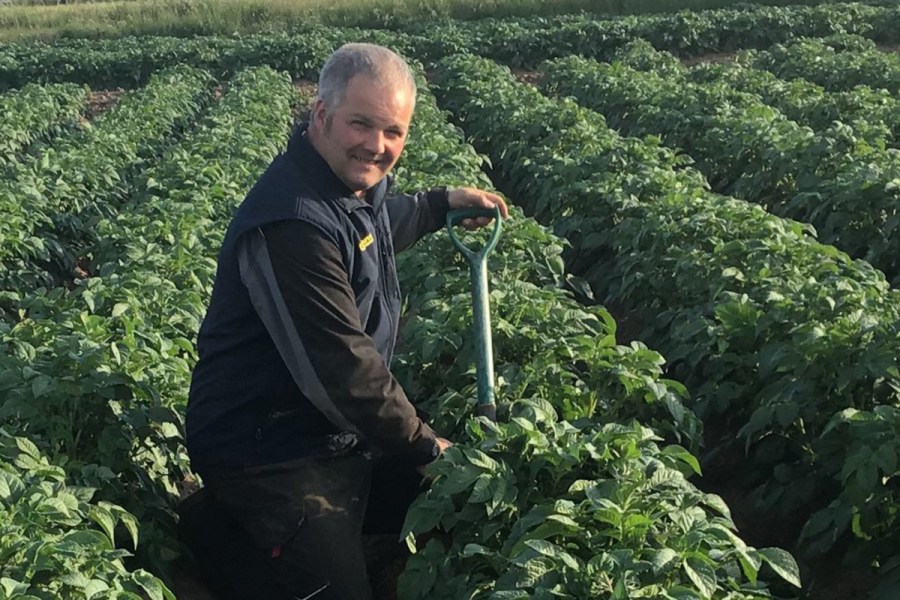By Andrew Wilson
So how’s it going? We’re about a month behind instead of what was three, so progress has been made.
My plan from last month has mostly gone ahead. We have enough malting barley sown to fill our contract and have a few oats in too – albeit there’s barely a full field sown due to wet patches we’ve had to go round.
The bean decision was down to ‘muck or nettles, they’re going in’ and were sown on 20 April, mostly driven by their soil conditioning and wheat entry characteristics rather than profitable farming. But if we sow nowt, then we harvest nowt.
Our winter barley has had all of its fertiliser; the wheat has only a small top up left depending on potential in the coming weeks; and we’ve managed to get some spraying done between the showers and high winds.
On the root crop front, as I write this on the last day of April, we have 8ha of our 20ha sugar beet crop sown, so a late start again. I placed some nutrition and biology under the seed behind the leading leg on our drilling rig. It’s not quite strip-till in the truest sense, but it’s made a significant difference to the travelability and subsequent soil damage levels at harvest in the wet seasons that seem to be coming more common.
We’ve sown some nurse barley in the lightest field where untreated seed is sown, and planted pollinator strips in all beet fields in an attempt to keep virus carrying aphids in check – there’s also a trial strip of in-furrow garlic granules for the same reason.
Potato planting is yet to start here, but at the present moment that isn’t a big problem. We still have 12ha each of beet, barley and oats to sow, and a myriad of other jobs to complete ideally before planting. And, our self-employed team members are, like us, not quite drilled up yet.
The muck and fert is on, covers topped, and inputs ready. The seed in chitting crates is in good order and poised ready for action, so once the weather stops drenching us every few days, we’ll be on. One of the benefits of halving our potato area a few years ago is that we can afford to wait for better conditions in times like this. Well planted, half grown and all that.
Given the short sharp windows of opportunity in recent months and building pressure on teams of people and machines on the ground, its perhaps timely that I bring safety to attention. It’s a subject that’s seen considerable focus on social media channels of late.
Way back in late 1999 I fell from a sugar beet cleaner onto the concrete workshop floor and put myself in the neurosurgeon’s department at Leeds General Infirmary for a week. I have no idea what they did while the lights were out for me, but boy am I glad they did it. I was very lucky indeed and bar a small patch of missing vision, I made a full recovery. Did I learn from it? Not entirely.
Rushing on filling a potato store a year later with the ‘emergency chairs’ of conveyors, I took a short cut too many and ended up with a foot stuck in a slewing elevator and on crutches for three months. Eventually the penny drops and it changes your perspective a bit.
Back then, the HSE was more about reducing accidents and less about making money than they seem to be now. They came to visit and asked me how such accidents could be prevented. I made a suggestion and they took it to the manufacturer who put out a modification to all known machines at a very low cost – proactive practical solutions for the benefit of all. The way things should be, in my humble opinion.
Things change though. Machinery is bigger, heavier, and less people are trying to do more in less time. Machines block and break in less than ideal conditions and tired operators don’t always follow text book rules. It’s human nature I suppose, to want to take the quickest route.
So where am I going with this? Quite simply, make the safe way the easy way. All the reams of paperwork won’t save lives and prevent accidents or stop corners from being cut, even if it does help when the excrement hits the proverbial fan blades.
What makes a difference in my view is quick, simple, convenient measures to assist staff in doing things safely. Safety specs in every tractor to keep eyes safe, changing wearing metal or using a cordless grinder in the field, suitable gloves in convenient places, a spare guarded pto shaft that would fit any destoner, a pair of axle stands sat on the trailer of potato planting paraphernalia to keep people safe under machines changing those few worn tiller blades while the headland gets ridged or whatever.
And, for heaven’s sake, please stop for a brew and a chat at least once a day. The talk of ‘the good old days’ is common – folk bemoaning that no one has time for anything these days. If twenty minutes or so can’t be spared in what will be days in the teens of hours for weeks on end, then the system needs tweaking.
Operators require a refuel and check over just like machines do. Without them, the whole job would grind to a halt pretty quickly. Safe planting everybody.
This article was taken from the latest issue of CPM. For more articles like this, subscribe here.
Sign up for Crop Production Magazine’s FREE e-newsletter here.




